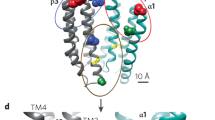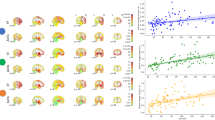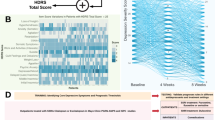Abstract
There is evidence that both cerebrospinal fluid (CSF) and plasma concentrations of 3α-reduced neuroactive steroids are decreased in major depressive disorder. Successful antidepressant pharmacotherapy, for example, with selective serotonin reuptake inhibitors (SSRIs), over several weeks is accompanied by an increase in CSF and plasma concentrations of these neuroactive steroids. However, no such increase has been observed during nonpharmacological treatments such as partial sleep deprivation or repetitive transcranial magnetic stimulation. In order to investigate whether concentration changes in neuroactive steroids are an important component of clinically effective antidepressant treatment, we examined plasma concentrations of the neuroactive steroids 3α,5α-tetrahydroprogesterone, 3α,5β-tetrahydroprogesterone, 3β,5α-tetrahydroprogesterone, and their precursors progesterone, 5α-dihydroprogesterone, and 5β-dihydroprogesterone in 31 pharmacotherapy-resistant depressed in-patients before and after unilateral electroconvulsive therapy (ECT) as a monotherapy over 4 weeks. Samples were quantified for neuroactive steroids by means of a highly sensitive and specific combined gas chromatography/mass spectrometry analysis. In all, 51.6% of the patients were treatment responders. There was no influence of ECT on the plasma concentrations of any neuroactive steroid studied. Moreover, neuroactive steroid levels did not differ between treatment responders and nonresponders. Our study shows that changes in neuroactive steroid plasma levels are not a mandatory factor for successful antidepressant treatment by ECT. Thus, the previously observed changes in plasma concentrations of neuroactive steroids following treatment with antidepressants such as SSRIs more likely reflect distinct pharmacological properties of these compounds rather than clinical improvement.
Similar content being viewed by others
Log in or create a free account to read this content
Gain free access to this article, as well as selected content from this journal and more on nature.com
or
References
Abrams R (2002a). Electroconvulsive Therapy. Oxford University Press: Oxford, New York.
Abrams R (2002b). Stimulus titration and ECT dosing. J ECT 18: 3–9.
Altar CA (1999). Neurotrophins and depression. Trends Pharmacol Sci 20: 59–61.
American Psychiatric Association (2000). Diagnostic and Statistical Manual of Mental Disorders DSM-IV-TR (Text Revision). APA: Washington, DC.
Corpechot C, Collins BE, Carey MP, Tsouros A, Robel P, Fry JP (1997). Brain neurosteroids during the mouse oestrous cycle. Brain Res 766: 276–280.
Crawley JN, Glowa JR, Majewska MD, Paul SM (1986). Anxiolytic activity of an endogenous adrenal steroid. Brain Res 398: 382–385.
d'Elia G (1970). Unilateral electroconvulsive therapy. Acta Psychiatr Scand Suppl 215: 1–98.
d'Elia G, Raotma H (1975). Is unilateral ECT less effective than bilateral ECT? Br J Psychiatry 126: 83–89.
ECT-review group (2003). Efficacy and safety of electroconvulsive therapy in depressive disorders: a systematic review and meta-analysis. Lancet 361: 799–808.
Florkowski CM, Crozier IG, Nightingale S, Evans MJ, Ellis MJ, Joyce P et al (1996). Plasma cortisol, PRL, ACTH, AVP and corticotrophin releasing hormone responses to direct current cardioversion and electroconvulsive therapy. Clin Endocrinol (Oxf) 44: 163–168.
Folkerts HW, Michael N, Tolle R, Schonauer K, Mucke S, Schulze-Monking H (1997). Electroconvulsive therapy vs paroxetine in treatment-resistant depression—a randomized study. Acta Psychiatr Scand 96: 334–342.
George MS, Guidotti A, Rubinow D, Pan B, Mikalauskas K, Post RM (1994). CSF neuroactive steroids in affective disorders: pregnenolone, progesterone, and DBI. Biol Psychiatry 35: 775–780.
Griffin LD, Mellon SH (1999). Selective serotonin reuptake inhibitors directly alter activity of neurosteroidogenic enzymes. Proc Natl Acad Sci USA 96: 13512–13517.
Grunhaus L, Zelnik T, Albala AA, Rabin D, Haskett RF, Zis AP et al (1987). Serial dexamethasone suppression tests in depressed patients treated only with electroconvulsive therapy. J Affect Disord 13: 233–240.
Hamilton M (1960). A rating scale for depression. J Neurol Neurosurg Psychiatry 23: 56–62.
Janicak PG, Davis JM, Gibbons RD, Ericksen S, Chang S, Gallagher P (1985). Efficacy of ECT: a meta-analysis. Am J Psychiatry 142: 297–302.
Khisti RT, Chopde CT, Jain SP (2000). Antidepressant-like effect of the neurosteroid 3alpha-hydroxy-5alpha-pregnan-20-one in mice forced swim test. Pharmacol Biochem Behav 67: 137–143.
Maitra R, Reynolds JN (1998). Modulation of GABA(A) receptor function by neuroactive steroids: evidence for heterogeneity of steroid sensitivity of recombinant GABA(A) receptor isoforms. Can J Physiol Pharmacol 76: 909–920.
Padberg F, Di Michele F, Zwanzger P, Romeo E, Bernardi G, Schule C et al (2002). Plasma concentrations of neuroactive steroids before and after repetitive transcranial magnetic stimulation in depression. Neuropsychopharmacology 27: 874–878.
Paul SM, Purdy RH (1992). Neuroactive steroids. FASEB J 6: 2311–2322.
Prince RJ, Simmonds MA (1992). 5 beta-pregnan-3 beta-ol-20-one, a specific antagonist at the neurosteroid site of the GABAA receptor-complex. Neurosci Lett 135: 273–275.
Prudic J, Haskett RF, Mulsant B, Malone KM, Pettinati HM, Stephens S et al (1996). Resistance to antidepressant medications and short-term clinical response to ECT. Am J Psychiatry 153: 985–992.
Prudic J, Sackeim HA, Devanand DP (1990). Medication resistance and clinical response to electroconvulsive therapy. Psychiatry Res 31: 287–296.
Romeo E, Cheney DL, Zivkovic I, Costa E, Guidotti A (1994). Mitochondrial diazepam-binding inhibitor receptor complex agonists antagonize dizocilpine amnesia: putative role for allopregnanolone. J Pharmacol Exp Ther 270: 89–96.
Romeo E, Strohle A, Spalletta G, Di Michele F, Hermann B, Holsboer F et al (1998). Effects of antidepressant treatment on neuroactive steroids in major depression. Am J Psychiatry 155: 910–913.
Rupprecht R (2003). Neuroactive steroids: mechanisms of action and neuropsychopharmacological properties. Psychoneuroendocrinology 28: 139–168.
Rupprecht R, Holsboer F (1999). Neuroactive steroids: mechanisms of action and neuropsychopharmacological perspectives. Trends Neurosci 22: 410–416.
Sackeim HA, Prudic J, Devanand DP, Kiersky JE, Fitzsimons L, Moody BJ et al (1993). Effects of stimulus intensity and electrode placement on the efficacy and cognitive effects of electroconvulsive therapy. N Engl J Med 328: 839–846.
Sackeim HA, Prudic J, Devanand DP, Nobler MS, Lisanby SH, Peyser S et al (2000). A prospective, randomized, double-blind comparison of bilateral and right unilateral electroconvulsive therapy at different stimulus intensities. Arch Gen Psychiatry 57: 425–434.
Schule C, Di Michele F, Baghai T, Romeo E, Bernardi G, Zwanzger P et al (2003). Influence of sleep deprivation on neuroactive steroids in major depression. Neuropsychopharmacology 28: 577–581.
Smith MA, Zhang LX, Lyons WE, Mamounas LA (1997). Anterograde transport of endogenous brain-derived neurotrophic factor in hippocampal mossy fibers. Neuroreport 8: 1829–1834.
Strohle A, Romeo E, Di Michele F, Pasini A, Yassouridis A, Holsboer F et al (2002). GABA(A) receptor-modulating neuroactive steroid composition in patients with panic disorder before and during paroxetine treatment. Am J Psychiatry 159: 145–147.
Uzunov DP, Cooper TB, Costa E, Guidotti A (1996). Fluoxetine-elicited changes in brain neurosteroid content measured by negative ion mass fragmentography. Proc Natl Acad Sci USA 93: 12599–12604.
Uzunova V, Sheline Y, Davis JM, Rasmusson A, Uzunov DP, Costa E et al (1998). Increase in the cerebrospinal fluid content of neurosteroids in patients with unipolar major depression who are receiving fluoxetine or fluvoxamine. Proc Natl Acad Sci USA 95: 3239–3244.
Wu JC, Bunney WE (1990). The biological basis of an antidepressant response to sleep deprivation and relapse: review and hypothesis. Am J Psychiatry 147: 14–21.
Acknowledgements
We thank Mrs M Ertl, Mrs A Johnson, and Mr K Neuner for patient nursing and laboratory assistance. This work was supported by a Tandem-project of the Max-Planck Society. Parts of this study were carried out in the framework of the doctoral thesis of Mrs Theresa Zeller, which have been submitted to the Faculty of Medicine, University of Munich.
Author information
Authors and Affiliations
Corresponding author
Rights and permissions
About this article
Cite this article
Baghai, T., di Michele, F., Schüle, C. et al. Plasma Concentrations of Neuroactive Steroids before and after Electroconvulsive Therapy in Major Depression. Neuropsychopharmacol 30, 1181–1186 (2005). https://doi.org/10.1038/sj.npp.1300684
Received:
Revised:
Accepted:
Published:
Issue date:
DOI: https://doi.org/10.1038/sj.npp.1300684
Keywords
This article is cited by
-
How electroconvulsive therapy works in the treatment of depression: is it the seizure, the electricity, or both?
Neuropsychopharmacology (2024)
-
Weak correlations between serum and cerebrospinal fluid levels of estradiol, progesterone and testosterone in males
BMC Neuroscience (2019)
-
Neurosteroids in the Pathophysiology and Treatment of Mood and Anxiety Disorders
Current Treatment Options in Psychiatry (2018)
-
Adverse effects of 5α-reductase inhibitors: What do we know, don’t know, and need to know?
Reviews in Endocrine and Metabolic Disorders (2015)
-
Cross-reactivity of steroid hormone immunoassays: clinical significance and two-dimensional molecular similarity prediction
BMC Clinical Pathology (2014)



